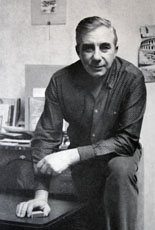
Unifying the extremes of reality and abstraction at the height of post-war cultural politics and intrigue, Gustave Singier and a small group of fellow artists including Jean Bazaine, Alfred Manessier, and Jean Le Moal established a new aesthetic of pure poetical expression, creating a fluid dialectical exchange between man and nature, comparable in literature to Proust and Joyce. This group, first known as Témoignage, was initially formed by Marcel Michaud in 1938 when they exhibited at René Bretau’s Galerie Matières, on Rue des Canettes, in Paris.
During the war, despite the Occupation, the group managed to hold two further highly important and controversial exhibitions in Paris, in protest of the Nazi’s neo-classical aestheticism and denigration of abstract art as “Degenerate”. The first, organised by Jean Bazaine and André Lejard at Galerie Braun in 1941, was Peintres de la Tradition Française, it included Singier, Le Moal, Bazaine, Manessier, Pignon, Gischia. The second, Douze Peintres D’Aujourd’hui, was in 1943 at Galerie de France. The group’s activities attracted the attention of a number of influential critics and art dealers, including René Drouin who purchased the present work from the artist in 1944. Drouin also held a high profile exhibition for Singier, Le Moal, and Manessier in 1946 titled “Trois Peintres”.
Having been born in Belgium, Singier moved to Paris in 1919, where he enrolled at the École Boule. In 1936 he began to exhibit regularly at the major avant-garde salons, Salon des Independants, 1936-1939; Salon d’Automne, 1939-1949; Salon des Tuileries, 1939-1942; and the Salon de Mai, from 1945 of which he was a co-founder. His first one-man exhibitions were at Galerie Billiet-Caputo, in 1949 and 1950. He then went on to have regular exhibitions in Paris at the prestigious Galerie de France, 1952, 1955, 1957, 1959, 1961. He also exhibited throughout Europe and internationally, with numerous one-man shows and major group shows of the French avant-garde, including “Younger European Painters” at the Solomon R. Guggenheim Museum, New York in 1954, and “École de Paris” at the Tate Gallery, London in 1962. He further participated in several International Biennial’s: Venice, 1954; Ljubljana, 1959; Turin, 1961; Tokyo, 1961; Sao Paulo, 1963.
Singier is internationally acclaimed as one of the foremost painters of the post-war School of Paris, and his work is represented in numerous major public collections including: Musée Nationale d’Art Moderne, Paris; Musée d’Art Moderne de la Ville, Paris; Tate Modern, London; Solomon R. Guggenheim Museum, New York; Pittsburgh; Toronto; Montreal; Sydney; Melbourne; Wellington; Johannesburg; Oslo; Skopje; Brussels; Luxemburg; Liège; Vienna; Basel.